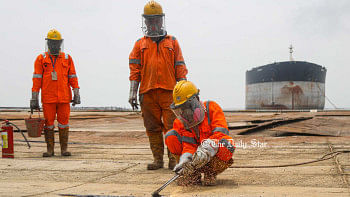South Asia should build a proper economic corridor

South Asia should put emphasis on building a proper economic corridor with the efficient utilisation of its port infrastructure to gain the benefits of multi-modal transport in cross-border logistics, according to experts.
They also stressed the need for leveraging policies and geopolitical issues to enhance economic growth and business activities in South Asia.
"Road connectivity and other necessary infrastructure has been built along the Bangladesh-India border but neither side is enjoying the benefit for technical issues, such as inefficiencies in port handling and customs," said Selim Raihan, a professor of economics at the University of Dhaka.
He made this comment while addressing a session on "Multi-Modal Transport (Cross-border Logistics)" at the Fourteenth South Asia Economic Summit.
The event was organised by the Centre for Policy Dialogue (CPD) at Sheraton Dhaka yesterday.
Raihan, also executive director of the South Asian Network on Economic Modeling, said it is meaningless if infrastructure development is restricted to the construction of decorative buildings with no real benefit to trade or business activities.
For example, India and Bangladesh have improved highway and railway connectivity but there has been no visible development in the soft infrastructure of their ports, he added.
Soft infrastructure refers to facilities related to port handling and customs, among other services.
With this backdrop, Raihan emphasised that planning and coordination should be aligned with regional or neighbouring countries during the construction of any project in order to get its maximum benefit.
He also said Bangladesh has borrowed large sums of money from bilateral and multilateral lenders to develop its connectivity with India, which is of benefit to other South Asian nations as well.
While presenting the keynote, Govind Raj Pokharel, former vice-chair of the National Planning Commission of Nepal, said they fast-tracked some infrastructure projects as a part of their plan to connect certain Indian highways with Kathmandu.
However, they are yet to get any benefit from the initiative, funded by China under its Belt and Road Initiative, due to geopolitical issues.
"Even SAARC has become dysfunctional due to a lack of coordination among member countries and so, nobody can benefit from it," he added.
Pokharel also said that if Nepal wants to increase trade with Bangladesh, then there needs to be tripartite discussions among the two countries and India.
So, leveraging policies and geopolitical issues is important to ensure multi-modal transport, he added.
Dushni Weerakoon, executive director of the Institute of Policy Studies of Sri Lanka, said they have developed a number of eye-catching infrastructures but are yet to enjoy the expected benefit.
"We have taken loans from China and India to develop these infrastructures but are now facing geopolitical issues, for which we are not getting the benefit," she added.
Weerakoon also stressed the need for coordination among concerned quarters to achieve trade and economic benefits.
Prabir De, a professor at the Research and Information System for Developing Countries in India, believes Bangladesh and India have developed road, rail, river and air connectivity that can bring a lot of benefit to countries in south and central Asia.
He said the newly established link between Sabroom in India and Ramgarh in Bangladesh is a new gateway for India as it will help transport goods to the seven sister states.
Prabir also suggested Bangladesh should utilise the cargo handling facility of Delhi airport.
"First, small sectors should try to take the benefit of these infrastructure and if it is doable, then large companies should follow suit," he added.
Among others, Abdul Ghufran Memon, secretary of the Ministry of Maritime Affairs of Pakistan, and Chewang Rinzin, director of the Royal Institute of Governance and Strategic Studies in Bhutan, addressed the session.

 For all latest news, follow The Daily Star's Google News channel.
For all latest news, follow The Daily Star's Google News channel. 



Comments